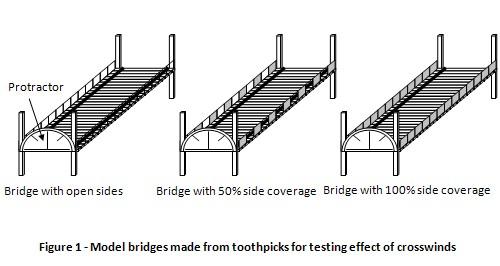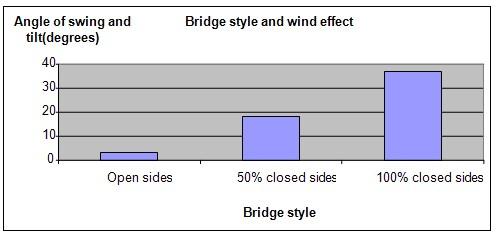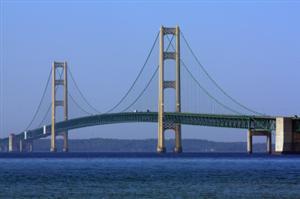| Complexity level: | 6 |
| Project cost ($): | 40 |
| Time required: | 2 days for preparation, 1 day for conducting the science project experiment |
| Material availability: | Building the bridge is fairly easy - the materials may be purchased at a supermarket/hobby store |
| Safety concerns: | Basic safety requirements |
Hypothesis
The bridge with minimal side-coverage will be the least affected by crosswinds.
Overview
Type of bridges
Bridges are used to provide assage across an obstacle such as a river valley or a road. The simplest form of a bridge is a beam bridge that can take the form of a log or a wooden plank across a drain or a river channel. More complicated arch bridges are typically made of stone. The oldest arch bridges were built by the Greeks.
The deck of the bridge is normally constructed at another location and will be transported to the installation site once it is completed. The deck will be lifted using a crane and both ends of the bridge will be placed on the ground at either sideSuspension bridges are popular because they can be built to span a greater distance compared to other types of bridges. The supporting beam of a suspension bridge is called an anchorage. The anchorage is embedded in a concrete base on the ground. Wire cables are used to suspend the deck of the bridge from the anchorage.
Scientific Terms
Materials
The materials required for this science fair project are:
- 1500 toothpicks
- 6 pairs of disposable chopsticks
- 1 box of clay
- 10 meters of string
- Letter sized paper
- 1 pair of scissors
- 3 bottles of glue
- 3 transparent protractors
- An industrial fan
Procedure
1. The independent variable for this science fair project is the type of bridge used – open sides, 50% side coverage and 100% side coverage. The dependent variable is the tilt of the angle of the bridge deck caused by the force of wind from the fan. This tilt angle is measured using a protractor placed on the bridge. The constants or control variables are: the speed of the wind from the fan, the length of the bridge, the width of the bridge and the weight of the bridge.

2. Figure 1 above is an illustration of the model bridges that you will need to construct for your science experiment. . The deck of the bridge is constructed using 500 toothpicks. The toothpick can be fixed onto the string using glue or by tying knots. The frame at the sides of the bridge can be made using strings and toothpicks. The paper should be cut according to the measurements required to cover the sides of the bridges up to 50% or 100% as shown in the figure above.
3. The first bridge with the open sides is placed at a distance of 1 meter from the industrial fan. The sides of the bridge are made to face the fan. Clay is used to secure the bridge firmly onto a flat surface (ie: table).
4. The motion of the bridge caused by the force of wind produced by the industrial fan is observed. Using the protractor, the angle of swing or tilt of the bridge is observed and recorded in the table provided below.
5. Step 4 is repeated using bridges with 50% covered sides and 100% covered sides respectively. Similarly, the angle of swing or tilt of the bridge is observed and recorded in the table provided below.


Results
The results show that the bridge with opensides has the least amount of tilt and swing caused by the wind from the fan. The bridge with 100% covered sides had the largest tilt angle.
| Bridge type | Open sides | 50% closed sides | 100% closed sides |
| Angle of swing and tilt | 3° | 18° | 37° |
Plot the results of your observation into a graph, as shown below.

Conclusion
The hypothesis that the bridge with minimal covering at the sides will be the least affected by crosswinds is proven to be true.
Building longer suspended bridges makes them more vulnerable to crosswinds and structural failures. An example is the Tacoma Bridge along State Route 16, which was opened on June 1, 1940 which collapsed 4 months later due to strong winds.
Also consider
This science fair project can also be repeated with larger sized model bridges of materials (eg. aluminium, cast iron) to understand how the density and weight of the materials used to construct the bridge affects its ability to withstand high speed winds.
This experiment can also be repeated using varying wind speeds, or by simulating earthquakes.
References
Procedures for bridge construction - http://www.ehow.com/how-does_5300825_procedure-bridge-construction.html
Bridge - http://en.wikipedia.org/wiki/Bridge

